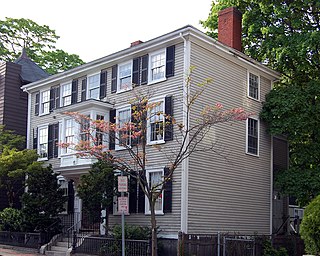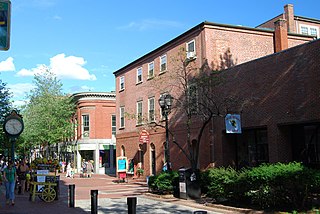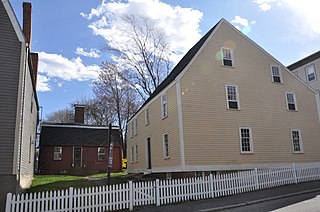
The Salem Maritime National Historic Site is a National Historic Site consisting of 12 historic structures, one replica tall-ship, and about 9 acres of land along the waterfront of Salem Harbor in Salem, Massachusetts. Salem Maritime is the first National Historic Site established in the United States. It interprets the Triangle Trade during the colonial period, in cotton, rum, sugar and slaves; the actions of privateers during the American Revolution; and global maritime trade with the Far East, after independence. The National Park Service manages both the National Historic Site and a Regional Visitor Center in downtown Salem. The National Park Service (NPS) is an agency of the United States Department of the Interior.

The Peirce–Nichols House is a historic house museum located at 80 Federal Street in Salem, Massachusetts. Designed early in the career of noted Salem builder Samuel McIntire (1757–1811), and modified later by him, the building gives a unique view into the methods and styles of McIntire. It was designated a National Historic Landmark in 1973 for its significance as an early masterwork of one of the country's first recognized master builders. It is now owned by the Peabody Essex Museum.

Hamilton Hall is a National Historic Landmark at 9 Chestnut Street in Salem, Massachusetts. Designed by noted Salem builder Samuel McIntire and built in 1805–07, it is an excellent instance of a public Federal style building. It was built as a social space for the leading families of Salem, and was named for Founding Father and Federalist Party leader Alexander Hamilton. It continues to function as a social hall today: it is used for events, private functions, weddings and is also home to a series of lectures that originated in 1944 by the Ladies Committee.

The Gardner–Pingree House is a historic house museum at 128 Essex Street in Salem, Massachusetts. It is judged to be a masterpiece of Federal architecture by the noted Salem builder Samuel McIntire, and was designated a National Historic Landmark in 1972 for its architectural significance. It is owned by the Peabody Essex Museum as part of its architectural collection, and is open to the public for guided tours.

Bowker Place is a historic commercial building at 144–156 Essex Street in Salem, Massachusetts. Built in 1830 by William Manning, this handsome two-story Greek Revival brick building has had a significant role in the civic and economic history of Salem. It was acquired by Joel Bowker in 1844 after Manning went bankrupt. Its tenants have included banks, insurance companies, and the Salem Police Court. One prominent retailer who began operations in this building was William Filene, founder of the Filene's department store chain.

The Central Street District is a historic district encompassing the traditional heart of Andover, Massachusetts prior to the development in the later 19th century of the current town center. It consists mainly of residential and religious properties along Central Street, from Phillips Street in the south to Essex Street in the north. All of the listed properties have frontage on Central Street, even if their addresses are on one of the adjacent streets.

The Charter Street Historic District encompasses a small remnant of the oldest part of Salem, Massachusetts that has since been surrounded by more modern development. It includes three properties on Charter Street: the Pickman House, the Grimshawe House, and the Charter Street Cemetery, or Central Burying Point. The district was listed on the National Register of Historic Places in 1975.

The Chestnut Street District is a historic district bounded roughly by Bridge, Lynn, Beckford, and River Streets in Salem, Massachusetts. It was added to the National Register of Historic Places in 1973 and enlarged slightly in 1978. The district contains a number of architecturally significant works of Samuel McIntire, a builder and woodworker who had a house and workshop at 31 Summer Street, and who designed and built a number of these houses, and others that display the profits made in the Old China Trade by Salem's merchants. The district is a subset of a larger locally designated McIntire Historic District.

The Rufus Choate House is a historic house at 14 Lynde Street in Salem, Massachusetts. It is primarily recognized for its association with lawyer and Federalist Party politician Rufus Choate (1799-1859), who lived here from about 1825 to 1834. It is a three-story Federal style wood-frame house that was built in 1805 by Ebenezer Beckford, a Salem merchant and real estate developer. Beckford, and later his same-named son, owned the property until 1841.

Downtown Salem District is a historic district roughly bounded by Church, Central, New Derby, and Washington Streets in Salem, Massachusetts. It was added to the National Register of Historic Places in 1983, and represents a major expansion of the Old Town Hall Historic District, which was listed in 1972.

The Essex Institute Historic District is a historic district at 134-132, 128, 126 Essex Street and 13 Washington Square West in Salem, Massachusetts. It consists of a compact group of properties associated with the Essex Institute, founded in 1848 and merged in 1992 into the Peabody Essex Museum. Listed by increasing street number, they are: the Crowninshield-Bentley House, the Gardner-Pingree House, the John Tucker Daland House, and the Phillips Library. The John Ward House, which fronts on Brown Street but shares the 132 Essex Street address, is another National Historic Landmark within the district. The Andrew Safford House at 13 Washington Square West, built in 1819, was said to be the most expensive home in New England at the time.

The Federal Street District is a residential and civic historic district in Salem, Massachusetts. It is an expansion of an earlier listing of the Essex County Court Buildings on the National Register of Historic Places in 1976. In addition to the former county court buildings included in the earlier listing, the district expansion in 1983 encompasses the entire block of Federal Street between Washington and North Streets. It includes buildings from 32 to 65 Federal Street, as well as the Tabernacle Church at 50 Washington Street.

The Gedney and Cox Houses are historic houses at 21 High Street in Salem, Massachusetts. The earliest part of the Gedney House was built c. 1665, and the houses were added to the National Register of Historic Places in 1974. They are owned by Historic New England, which offers limited tours.

The Robert "King" Hooper Mansion, built in 1728, is a historic house in Marblehead, Massachusetts. The oldest section of the mansion was built by candlemaker Greenfield Hooper, and his son, Robert "King" Hooper, expanded the house, adding it's three-story Georgian façade c. 1745. Hooper made his fortune through the transatlantic fishing business.

The River Road–Cross Street Historic District is a rural agricultural historic district in Topsfield, Massachusetts. It is representative of Topsfield's development first as an agricultural community, and later as place for rural retreats. The district, which was listed on the National Register of Historic Places in 2005, is roughly bounded by River Road, Rowley Bridge Road, Cross Street, Hill Street, and Salem Road, and also includes properties facing Prospect Street and Bradstreet Lane. Much of the district was consolidated under the ownership of William Appleton Coolidge in the 20th century, and bequeathed to the Massachusetts Institute of Technology with restrictions to preserve its rural character. MIT sold the donated properties in 2000.

The Washington Street Historic District encompasses a fashionable 19th-century residential area near downtown Peabody, Massachusetts. It extends along Washington, Holten, and Sewall Streets, and is where business and civic leaders of the community built their homes. The district was added to the National Register of Historic Places in 1985.

The Joshua Ward House is a historic house in Salem, Massachusetts. The three-story Federal style brick house, built in 1784, is one of the first brick houses in Salem. Its interior woodwork was done by noted Salem builder and woodworker Samuel McIntire, including an original staircase that is the oldest surviving staircase created by him. George Washington is reported to have specifically requested staying in this house when he visited Salem in 1789.

Salem Common Historic District is a historic district bounded roughly by Bridge, Derby, and St. Peter's streets, as well as Collins Cove in Salem, Massachusetts, United States.
This is a timeline of the history of the city of Salem, Massachusetts, United States.






















